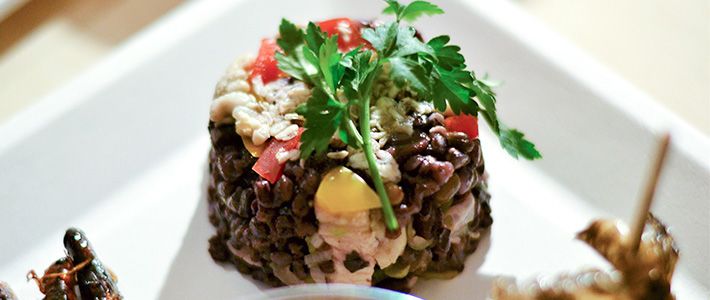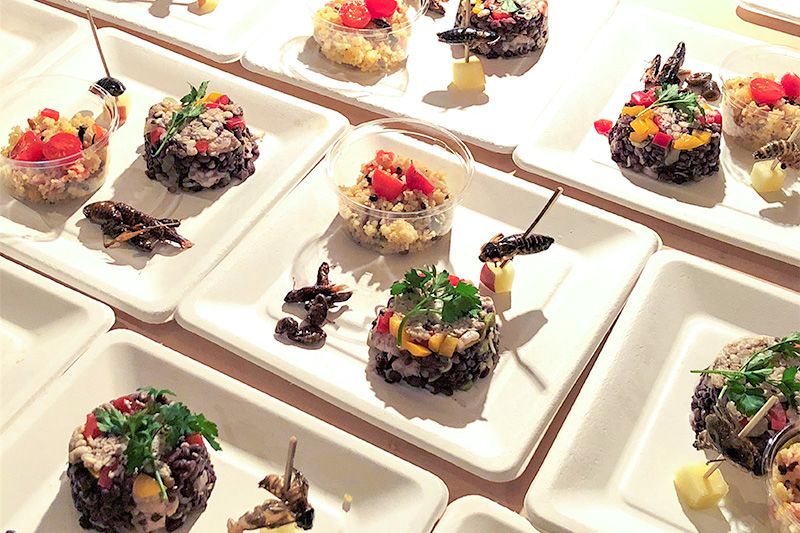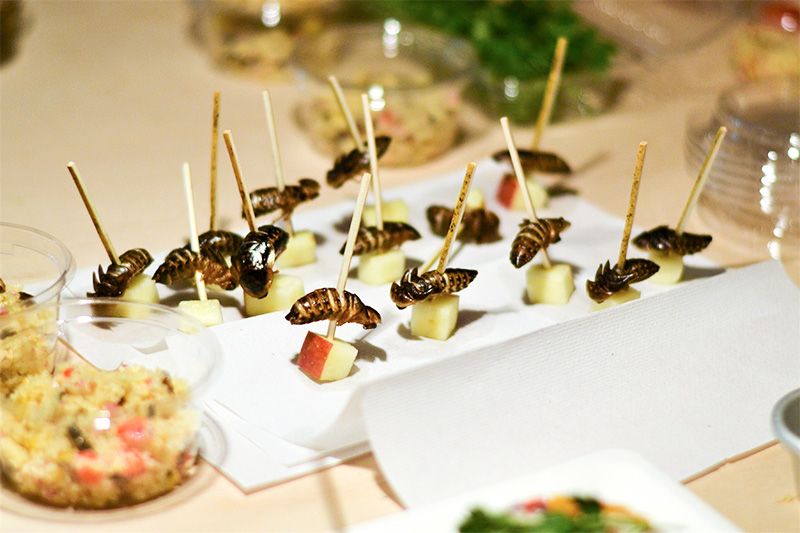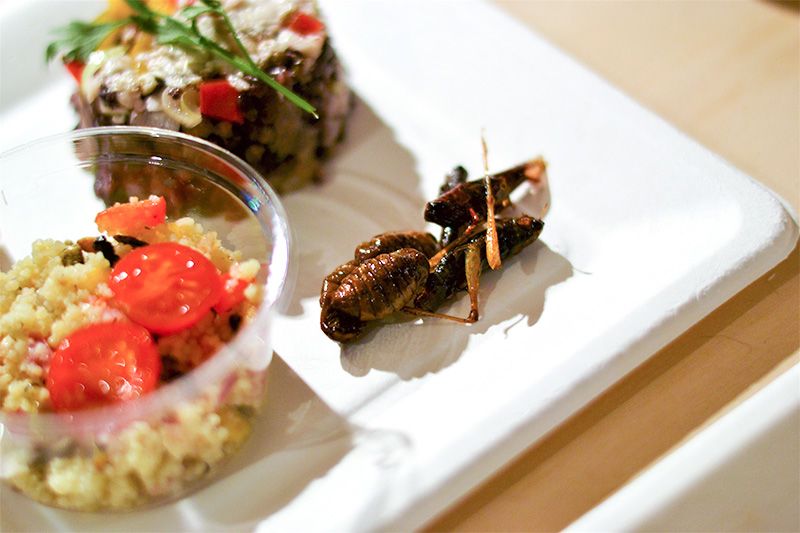
Creepy Crawly Cuisine: Exploring Insects as the Future of Food
Culture- English
- 日本語
- 简体字
- 繁體字
- Français
- Español
- العربية
- Русский
Global food shortages caused by overpopulation have long been on the radar as potential threats to humankind. And it is increasingly common knowledge that insects could provide a helpful nutritional alternative to current food sources. For the moment, though, there are few people actively considering the possibility of including bugs in their diet.
Not that this would be a culinary innovation, necessarily. Many cultures, including Thailand and Japan, feature insects such as silkworms as parts of the diet in some regions. And there are people working to give bugs a larger presence in the food cultures of the world by writing about insects as food and holding special events to showcase the possibilities.
Some of these people came together at a recent event in Tokyo for those looking to expand their culinary horizons: Konchūshoku Night, an insect-tasting event held on February 15 at the Shigoto Bar near Tokyo’s Kiyosumi-shirakawa subway station.
Bee-Larva Couscous and Cockroach Skewers
The event, attended by some 30 people, was headed by three experts in the field of cooking and eating insects: Mushimoiselle Giriko, an insect cuisine researcher and author of Mushikui nōto (Insect-Tasting Notebook); Miyashita Sei, a designer who runs the Tokyo bar Kome to Circus (Rice and Circus), where she has introduced insects on the menu; and Hosoi Aya, a gastronomic journalist who specializes, among other topics, in this peculiar branch of the kitchen.
 The Konchūshoku Night menu featured five types of insects for participants’ tasting pleasure.
The Konchūshoku Night menu featured five types of insects for participants’ tasting pleasure.
The dishes served included a couscous of black bee larvae prepared by Mushimoiselle, whose name itself is a play on mushi, “bug,” and mademoiselle. There were also a grasshopper-and-worm tsukudani (preserves created by simmering ingredients in soy sauce), a salad of rice with cereals and Thai weaver ants cooked au naturel, and Dubia cockroaches from Argentina skewered with fruit.
“The bee larvae combine very well with the couscous,” explains Mushimoiselle, who also notes that grasshopper and silkworm tsukudani are traditionally eaten in some regions of Japan. “The Argentinian cockroach is served well fried. I’ve combined it with fruit because this insect loves to eat it,” she tells us.
But what are the advantages of eating insects, there being so many other things to fill the stomach? Mushimoiselle explains that insects are a good source of proteins and amino acids. “There’s talk of a possible future with shortages of food due to global overpopulation. But the issue isn’t that we lack enough food—it’s that we cannot access an adequate supply of protein. Insects, being a rich source of protein, are an ideal food.”
 The Argentinian cockroach pairs very well with the apple.
The Argentinian cockroach pairs very well with the apple.
The Psychological Barrier of the First Bite
Despite the advantages of this food as explained by the event organizers, some of the participants still have a visibly hard time taking their first bite. Hosoi Aya speaks about the advantages of overcoming this psychological barrier: “If we stop thinking of insects as disgusting beings, we will understand that they can also be a food. If we overcome this fear, they may help us survive in the future.”
Hosoi started eating insects about 10 years ago while in Thailand, a country where such snacks are available at street stalls. “The difference in yourself comes with your first bite. Once you try your first insect, you feel you can dare anything.” And her experience is borne out by others at the Tokyo event: “Some of the people who participated tonight started by tasting something small, like a weaver ant from a friend’s plate. It all snowballs from there.”
Social networks like Instagram and some personalities from the entertainment world have helped to popularize events like this one, in which insects are cooked and eaten. Seeing Hollywood actresses like Angelina Jolie snacking on bugs has also encouraged more people to try them.
Insects in Aisle Three?
The day when insects are sold for human consumption in supermarkets still seems far away, although Mushimoiselle assures us that in some countries this is already a reality. “Even right here in Japan, it’s already possible to buy silkworm tsukudani in some supermarkets in Nagano Prefecture. It’s entirely possible that we’ll see other insects added to this list.”
 Tsukudani of silkworm and grasshopper is part of the gastronomic tradition of Japan.
Tsukudani of silkworm and grasshopper is part of the gastronomic tradition of Japan.
It seems obvious, however, that this will not happen in the near future. To procure insects guaranteed safe for human consumption, the organizers of the event turned to the Tokyo-based company Dubia Japan, which specializes in the breeding of these small beings. Company president Imai Yoshiaki explains that although at first he raised insects as food for reptiles, he now also specializes in breeding for human consumption.
“The most difficult thing when breeding insects is to control the humidity level. Insects do much better when it’s hot,” he tells us. Dubia Japan focuses in particular on the Argentine cockroach and the silkworm, feeding its insects a healthy diet of vegetables and fruit. “I hope we’ll be able to sell our bugs in supermarkets soon!” laughs Imai.
Before we dig into an entomophagic feast, though, we must take some dangers into account. The poison of insects like the blister beetle does not break down when heated, making them a dangerous ingredient for humans. “Most insects are safe for human consumption if they are cooked well,” says Mushimoiselle, “but as with meat, it’s generally not good to eat them raw.”
If this culinary culture continues to expand, there may come a day when we do not mind at all finding a bug in our soup.
(Originally published in Spanish on February 19, 2018. Banner photo: A nutritious rice salad with cereals and weaver ants from Thailand.)